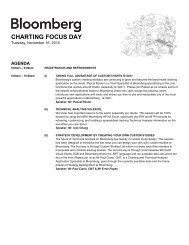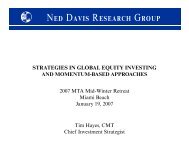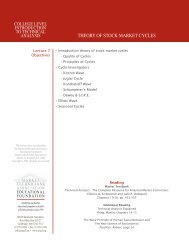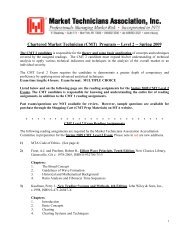Journal of Technical Analysis - Market Technicians Association
Journal of Technical Analysis - Market Technicians Association
Journal of Technical Analysis - Market Technicians Association
Create successful ePaper yourself
Turn your PDF publications into a flip-book with our unique Google optimized e-Paper software.
56<br />
Benner’s Prophecies <strong>of</strong> Future Ups and Downs in Prices 1<br />
Samuel Benner<br />
Panic<br />
Jo u r n a l <strong>of</strong> <strong>Technical</strong> <strong>Analysis</strong> • 2008 • Issue 65<br />
7<br />
Panics in the commercial and financial world have been compared to comets in the astronomical world. It has been said <strong>of</strong> comets that they have no regularity <strong>of</strong><br />
movement, no cycles, and that their movements are beyond the domain <strong>of</strong> astronomical science to find out. However, the writer claims that Commercial Revulsions<br />
in this country, which are attended with financial panics, can be predicted with much certainty; and the prediction in this book, <strong>of</strong> a commercial revolution and<br />
financial crisis in 1891 is based upon the inevitable cycle which is ever true to the laws <strong>of</strong> trade, as affected and ruled by the operations <strong>of</strong> the laws <strong>of</strong> natural<br />
causes.<br />
The panic <strong>of</strong> 1873 was a commercial revolution; our paper money was not based upon specie, and banks only suspended currency payments for a time in this crisis.<br />
As it is not in the nature <strong>of</strong> things in succeeding cycles to operate in the same manner, the writer claims that the “signs <strong>of</strong> the times” indicate that the coming<br />
predicted disturbance in the business world will be not only an agricultural, manufacturing, mining, trading, and industrial revulsion, but also a financial catastrophe,<br />
producing a universal suspension <strong>of</strong> payments and bank closures.<br />
It is not necessary to give a detailed account <strong>of</strong> the effects <strong>of</strong> disorderly banking in our colonial and revolutionary history, and the different panics prior to the<br />
war <strong>of</strong> 1812, to establish cycles in commerce and finance.<br />
Such a history would fill many pages without answering the purpose <strong>of</strong> this book, and would be as intricate and difficult to understand as the prices <strong>of</strong> stocks and<br />
gold in Wall Street.<br />
1 [Editor Note … Benner’s use <strong>of</strong> the word depression means bear market trend or economic contraction. The 1819 bank collapse from the cost <strong>of</strong> war, excess currency in circulation, and money moving<br />
out <strong>of</strong> the country is well defined. Benner’s economic forecast for a recession in 1891, though written in 1884, is only <strong>of</strong>f a year. The true brilliance is Benner’s cyclical analysis work throughout this book.<br />
Benner’s book was first published in 1875 and is widely viewed as the first market analysis book written in North America. This excerpt begins on page 96 after a detailed study <strong>of</strong> high to low price cycles<br />
in Steel, Hogs, Corn, and Cotton. Long term cycle analysts <strong>of</strong> today’s markets will find Benner provides annual market data from 1821 in this book.]

















